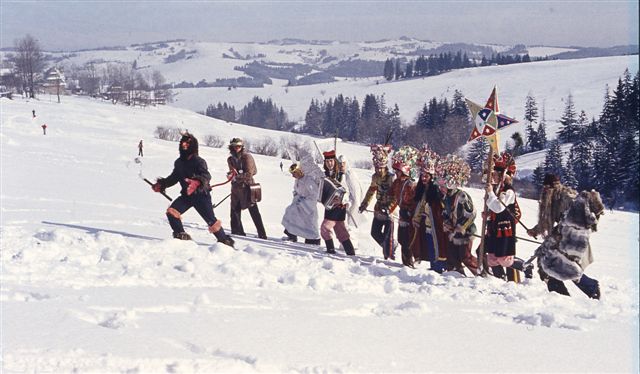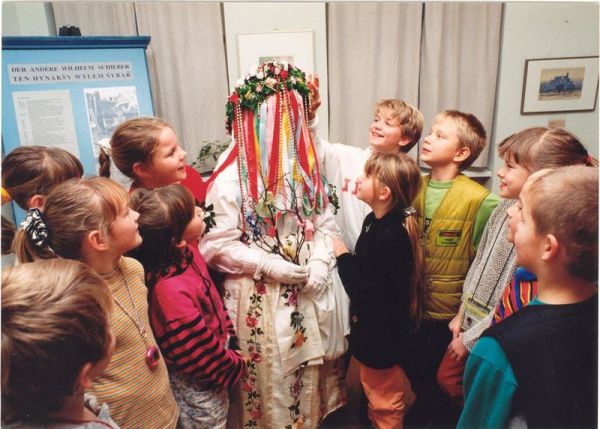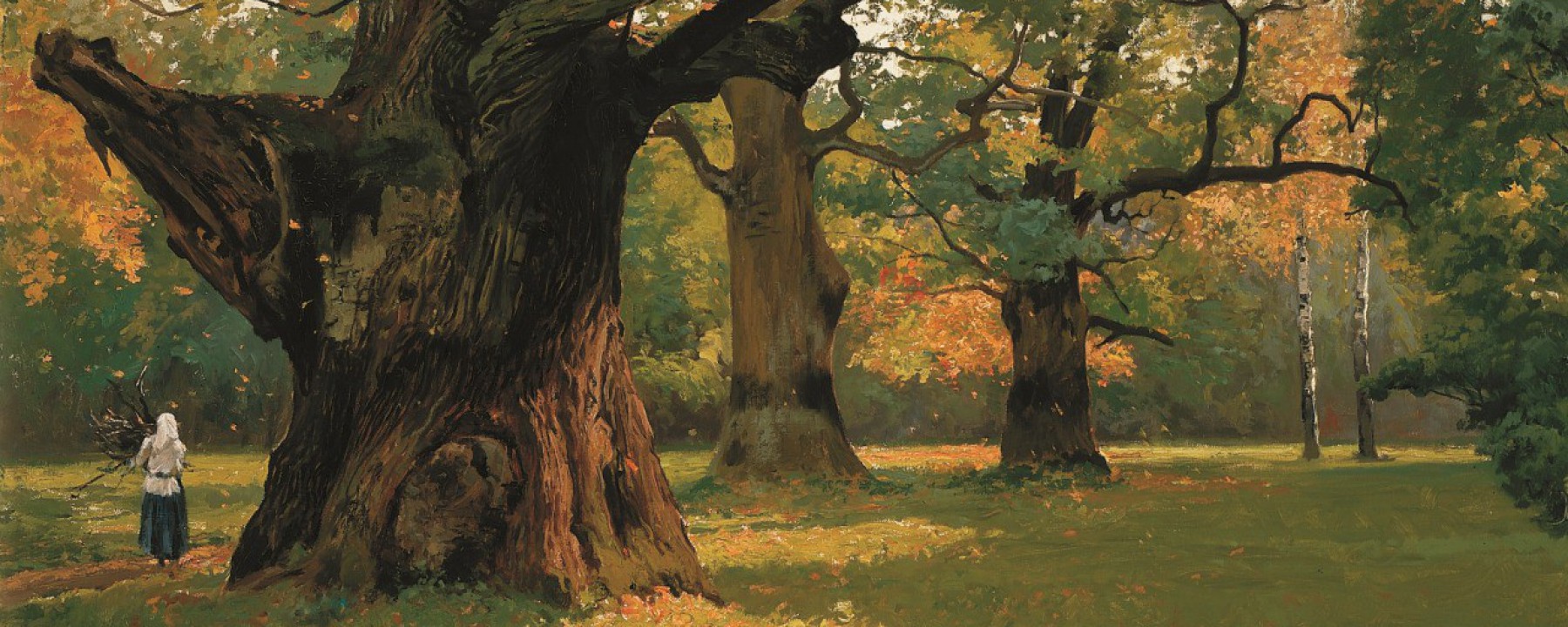
Today I’d like to introduce you to two mysterious characters from Polish folklore, and to a few other elements related to pre-Christian Slavic celebrations of the winter solstice and the later season of carnival. Informations about them survived in local folk customs, to be precise in Christmas rites called in Polish kolędowanie or kolęda (known in English as Slavic caroling).
These rites are rooted in pre-Christian winter rituals performed after the winter solstice when the days are growing longer. The rural communities were commemorating certain rites during that season: among others, groups of young people were getting dressed in symbolic costumes and going door-to-door in order to ‘announce’ the joyful time when the grim winter starts passing away. They were singing kolędy (joyful songs), reciting amusing rhymes, playing various harmless pranks, and in the end they were getting treats, drinks or small money from all the households in the community. People performing in such groups are called kolędnicy in Polish, and a noun for the custom itself is kolędowanie. In the process of syncretism the old meaning of the word kolęda (a joyful song) gained a meaning of a ‘Christmas song’, a carol, and it is how the word is understood by majority of the Christian Poles nowadays. In the past when kolęda had still the original meaning, there used to be also e.g. processions of ‘wiosenne kolędy’ (joyful songs of spring).
Nowadays, the season of kolędowanie starts after the Christmas Eve, and lasts usually for the whole January – even up until the beginning of February. Therefore, it is strongly related to the origins of the customs known in other cultures as a carnival (season that in the Polish folklore was known under a name of zapusty). I will describe the custom of kolędowanie in more details later in a separate article, and at the moment you can browse through my tag kolędowanie here to see examples of the symbolic costumes used in this custom in various parts of Poland and read a little about their meaning.

Gwiazdor (gvee-yaz-dhor) is a character known from the rites of kolędowanie who asks about good and bad deeds, and and who brings gifts during and after Christmas (originally after the winter solstice). He appears mainly in the region of Kashubia (Kaszuby), the regions of Greater Poland (Wielkopolska), Kuyavia-Pomerania (Kujawsko-Pomorskie), Lubuskie, and in some parts of the region of Warmia – in short, some areas of the western and northern Poland.
His name is derived from the word ‘gwiazda’ that means a star, and can be translated rougly as a ‘Star-Man’ or ‘Man of the Stars’. In the Kashubian language his name is spelled ‘Gwiôzdór’. There are also other versions of his name that appear in these regions, for example ‘Gwiżdż’, roughly derived from the verb gwizdać that means to whistle (the groups of kolędnicy in general were walking around making lots of different noises in order to ‘scare away the winter’). There are also numerous other related characters in other parts of Poland.



The origins of Gwiazdor are hard to trace. He is a unique character based on a certain archetype of an old all-knowing man arriving from the outerworld, possibly based on old Western Slavic winter deities. In the modern-day Poland his name is often mistakenly used as a synonym for the Santa Claus in the regions mentioned above. He is known to leave gifts under the Christmas tree in these regions.
Gwiazdor as a character in the rites of kolędowanie wears a wooden mask with a beard made of straw, a long coat made of either fur or of woven straw, and his accessories are bells and various types of rods. Sometimes he appears wearing a high ‘crown’ made of woven straw, but very often wears just a typical rural high cap made of leather or fur. He often carries a bag with small gifts for the children, in which he also keeps small birch-rods (rózgi) as a ‘gift’ for those who weren’t dutiful during the year.



Two facts are particularly important in the descriptions of his appearance. In the old-Slavic rites wearing a mask was generally reserved for symbolic ancestors or characters arriving from the outerworld. Similar wooden masks from around 1000 years ago were unearthed in many Polish archaeological sites. They are known in Polish as karaboszki. Straw as such is also a crucial detail as well: it was extremely important in the Polish folklore, widely used in numerous rites as a symbolic ‘magical barrier‘. In the context of folk rites of the pre-Christian origins such costumes are widely known as costumes of conductors of rites who were meant to embody the ancestors or even the gods without harming themselves or the people around them (straw used either as a barrier holding the summoned souls inside of the skilled conductors or as a protection, keeping the souls away from them).

In the other regions of Poland there are many kinds of similar characters wearing analogous costumes, all rooted in the old-Slavic winter rites syncretized in the custom of kolędowanie. These characters were appearing under various different names, for example Wigiliorze or Wiliarze, Starcaki, Szczodrzaki, Józefy (very often in plural forms, and appearing in groups), and many others. They are very often associated with a notion of ‘ancestors’.


Gwiazdor was often accompanied by a Gwiazdka (gvee-yaz-dkah), whose name can be translated as a ‘Little Star’ or a ‘Star-Woman’. Some sources call her “Piękna Pani” (A Beautiful Lady). It’s a mysterious woman who usually weren’t speaking a word. She’s dressed in a long white dress and wore a wreath made of flowers and ribbons. Her face was often covered with either a veil or a thin material. Her costume included elements made of straw, flowers, and many colorful ribbons.
Over the course of time and in the process of syncretism she was gradually replaced by a typical figure of an ‘Angel’ (still called a ‘Gwiazdka’ in most of the cases). In the present days she often appears also as a figure of a veiled ‘Bride’ among the groups of kolędnicy.
In the Polish folklore the character of a Gwiazdka started disappearing much sooner than the Gwiazdor, and there are even less informations about her and very sparse ethnographic materials. However, many ethnographers point out at the similarities between old descriptions of Gwiazdka and a mysterious women from Sorbian folklore (Sorbs, also known as e.g. Lusatians or Wends, are an old Slavic ethnic minority living in the areas of eastern Germany – their folklore is related to the Kashubian folklore and other Western Slavic folklores, and the historical region of Lusatia stretches to some parts of Poland’s western region of Lubuskie). Among the Lusatians, there is a surviving custom in which a character called ‘Dźěćetko’ (Little Child), ‘Bože dźěćo’ (God’s Child) or ‘Borborka’ visits children before Christmas. She’s dressed in a regional folk costume and covers the face with a veil. Some of her descriptions are strikingly similar to those of Gwiazdka from the Slavic folklore of northern and western Poland.

These characters aren’t the only element relater to a ‘star’ in the Polish folklore. The groups of kolędnicy walking from house to house are well-known to carry a big colorful star in front of them. It’s a common element in these rites among almost all of Western and Eastern Slavic folklores. The star is usually very colorful and often precisely crafted: a special mechanism can allow it to spin around while being carried on a long stick.
Carrying the star and singing the joyful songs was related to old-Slavic rituals of welcoming the ‘newborn Sun’ – in the Polish folklore there was a belief that a new Sun was being born each winter solstice. Before Christianity, the Slavic people celebrated that time as a feast of the (re)born Sun during old-Slavic holidays called in Polish Szczodre Gody (A Generous Feast).


Important in that matter is also the traditional custom of waiting for the ‘First Star’ (Pierwsza Gwiazdka) to appear on the sky before dining on the Christmas Eve, which is the most important day of the Christmas celebrations among the Polish people. This custom is known all over Poland, and is still celebrated by most of the people.
On that evening the people, usually children, are carefully observing the sky on the day of the 24th December, looking for the first star to shine. When it appears, it is a sign for the family that the celebrations might get started and they might already sit by the Christmas table to dine. A person who notices the ‘First Star’ as the first and announces its appearance is said to get the most of luck for the whole upcoming year.
In the common Polish speech (and many dialects) the Christmas Eve is straighforwardly called a ‘Gwiazdka’ instead of the regular Polish word Wigilia meaning the Christmas Eve supper.


It’s hard to draw clear conclusions in context of all the mentioned star-related symbolism in the Polish celebrations of the Christmas, New Year’s and carnival seasons. In the modern Polish folklore some of the elements are undoubtely influenced by Christianity, namely the story about the Star of Betlehem. However, most of the elements and the ways they’re performed and celebrated in the original old-Polish folklore draw clear connections to the pre-Christian ‘pagan’ Slavic rituals related to the season of winter solstice and the ‘newborn Sun’ taking over the sky, making the days grow longer.
Sources / more to read in Polish:
- “Gwiazdka i Gwiazdor”
- “Kto Słowianom prezenty nosił? O Spasie, Dziadku Mrozie i Gwiazdorze”
- “Boże Narodzenie… nowego Słońca! Szczodre Gody”
- “Przebierańcy gwiżdże”
- “Kolęda i kolędnicy”
- “Kultura ludowa Wielkopolski”
- Gwiazdor – Wikipedia
Shorter rebloggable post about Gwiazdor and Gwiazdka on my tumblr.

Thank for sharing the richness of Polish heritage with everyone. Most descendants of Polish ethnicity don’t have a clue of how great and influential the Kingdom and later Nation of Poland actually was. During early U.S. census many immigrants had to claim they were from Germany or Ukraine but what is enlightening is the stated language they spoke, Polish. I always joke that Poland was taken over so easily because we are basically an easy going people that love to party and feed everyone! Anyone that had a Polish Mother or Grandma will confirm that! We come from a culture of great artisan’s and thinkers that influenced Eastern Europe through out the centuries! Proud to be Polish and pass it on to next generations here in the US. Thank you again
LikeLike